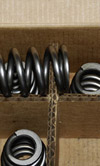The sting is in the beehive
 Donn Rickard was designing valve springs even before 1981, when he started R/D Valve Springs in Hesperia, California. A veteran of the racing game, Rickard is responsible for design work and farms out his actual manufacturing to Performance Springs, Inc. in Michigan, known throughout the industry by their acronym, PSI.
Donn Rickard was designing valve springs even before 1981, when he started R/D Valve Springs in Hesperia, California. A veteran of the racing game, Rickard is responsible for design work and farms out his actual manufacturing to Performance Springs, Inc. in Michigan, known throughout the industry by their acronym, PSI.
“In the late 1990s I helped design the current racing valve spring and it really hasn’t changed much over the years. It is still made of an alloy silicon chrome with vanadium added to the mixture,” Rickard told me.
The only real manufacturing changes he’s noted were that the materials have got better over the last four years. Where once all units were shot-peened, there is now a micron beam used in manufacturing with very tiny shot polishing added that reduces fatigue, he said. While the finish is still silver, it’s more of a matte colour.
“We have taken the polish off and this micro-peen adds to the longevity and lack of fatigue,” Rickard said. The micro peen process utilises very small shot media, producing an extremely high compressive stress layer on the surface of the spring which, in turn, reduces the likelihood of surface initiated failures.
The use of symmetrical springs has decreased among racers who use single springs look to the ‘beehive’ valve for their applications. The beehive valve spring gets smaller as it gets taller and the thickness changes, as well, although this shape is more of a fir cone than a simple traffic cone shape. “With the beehive valve spring, you don’t need a damper because there is no harmonic frequency change. The top retainer is smaller and lighter, too.”
Tony Oddo, engine builder for Bill McAnally Racing’s NASCAR Camping World Series West driver Paulie Harraka, is sold on the PSI beehive valve spring, he told me.
“They really seem to hold up well,” he said. “We are able to run smaller retainers and keepers, so there is less weight to the whole valvetrain.” He has been using this product exclusively for the past five years, in the LS2 NASCAR spec engines he builds.
Oddo finds there is a substantial change in diameter from bottom to top of the spring and he attains considerable weight savings, as well. “The savings on the whole valvetrain,” Oddo cited, “are between 20-30 grams and any time you take a gram off the valvetrain, it is a big deal.”
The older type of spring has a larger diameter than the current beehive valve spring and needs a damper and inner spring inside. “They were really heavy,” Oddo said. “We had to work them very hard to get them to push weight.”
The older spring could only be revved to 7500 rpm. “We had to work those springs really hard to get them to push weight. The installation of beehive valve springs “allows us to spin the engine harder. When you have a real light valvetrain, you can spin the motor to 8000-8200 rpm, while still pushing 300-350 pounds.”
Service life of the valve spring has also doubled to between 3-4 races, a cost savings for any engine builder. “We don’t have any problems with them as long as the driver doesn’t overheat the engine,” Oddo explained. “When that happens, it takes about 20-30 pounds right out of the spring,” and lessens valvetrain life.
Written by Anne Proffit.